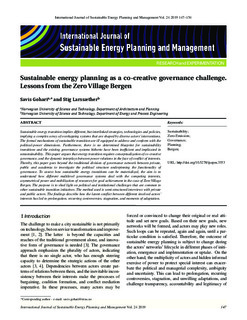| dc.contributor.author | Gohari, Savis | |
| dc.contributor.author | Larssæther, Stig | |
| dc.date.accessioned | 2019-12-02T13:37:00Z | |
| dc.date.available | 2019-12-02T13:37:00Z | |
| dc.date.created | 2019-11-26T09:16:08Z | |
| dc.date.issued | 2019 | |
| dc.identifier.citation | International Journal of Sustainable Energy Planning and Management. 2019, 24 147-154. | nb_NO |
| dc.identifier.issn | 2246-2929 | |
| dc.identifier.uri | http://hdl.handle.net/11250/2631283 | |
| dc.description.abstract | Sustainable energy transition implies different, but interlinked strategies, technologies and policy interventions, implying a complex array of overlapping systems that are shaped by the intervention of diverse actors. The formal mechanisms of transition to sustainability are ill equipped to address and conform with the political and power dimensions. Furthermore, there is no determined blueprint for sustainability transitions and the existing governance systems hitherto have been inefficient and implicated in unsustainability. This paper argues that energy transition requires conceptualization of co-creative governance, and the dynamic interplays between power relations in the face of conflict of interests. Thereby, this paper goes beyond the traditional division of governance network between private, public and academia to investigate the political structure underpinning the functionality of governance. To assess how sustainable energy transitions can be materialized, the aim is to understand how different multilevel governance systems deal with the competing interests, asymmetrical power and mobilization of resources for goal achievement in the case of Zero Village Bergen. It describes how the latent conflict between different involved actors’ interests has led to prolongation, recurring controversies, stagnation, and moments of adaptation. The purpose is to shed light on political and institutional challenges that are common to other sustainable transition initiatives. The method used is semi-structured interviews with private and public actors. The contribution is to theory building in sustainable energy planning from a governance lens. | nb_NO |
| dc.language.iso | eng | nb_NO |
| dc.publisher | Aalborg Universitetsforlag: IJSEPM | nb_NO |
| dc.rights | Attribution-NonCommercial-NoDerivatives 4.0 Internasjonal | * |
| dc.rights.uri | http://creativecommons.org/licenses/by-nc-nd/4.0/deed.no | * |
| dc.title | Sustainable energy planning as a co-creative governance challenge. Lessons from the Zero Village Bergen | nb_NO |
| dc.type | Journal article | nb_NO |
| dc.type | Peer reviewed | nb_NO |
| dc.description.version | acceptedVersion | nb_NO |
| dc.source.pagenumber | 147-154 | nb_NO |
| dc.source.volume | 24 | nb_NO |
| dc.source.journal | International Journal of Sustainable Energy Planning and Management | nb_NO |
| dc.identifier.doi | 10.5278/ijsepm.3353 | |
| dc.identifier.cristin | 1752193 | |
| dc.relation.project | Norges forskningsråd: 90112700 | nb_NO |
| dc.description.localcode | © 2019. This is the authors' accepted and refereed manuscript to the article. The final authenticated version is available online at: 10.5278/ijsepm.3353 | nb_NO |
| cristin.unitcode | 194,61,50,0 | |
| cristin.unitcode | 194,64,25,0 | |
| cristin.unitname | Institutt for arkitektur og planlegging | |
| cristin.unitname | Institutt for energi- og prosessteknikk | |
| cristin.ispublished | true | |
| cristin.fulltext | original | |
| cristin.qualitycode | 1 | |

